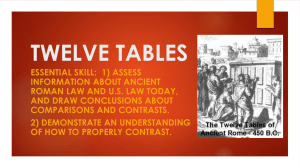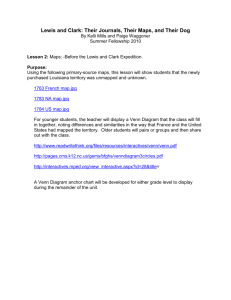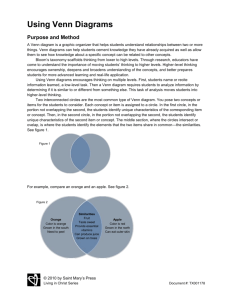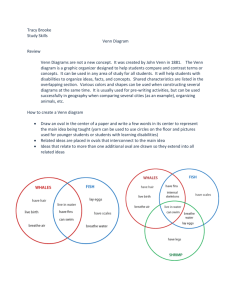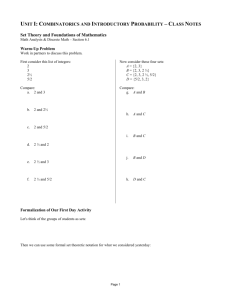LAKE COUNTY SCHOOLS
advertisement
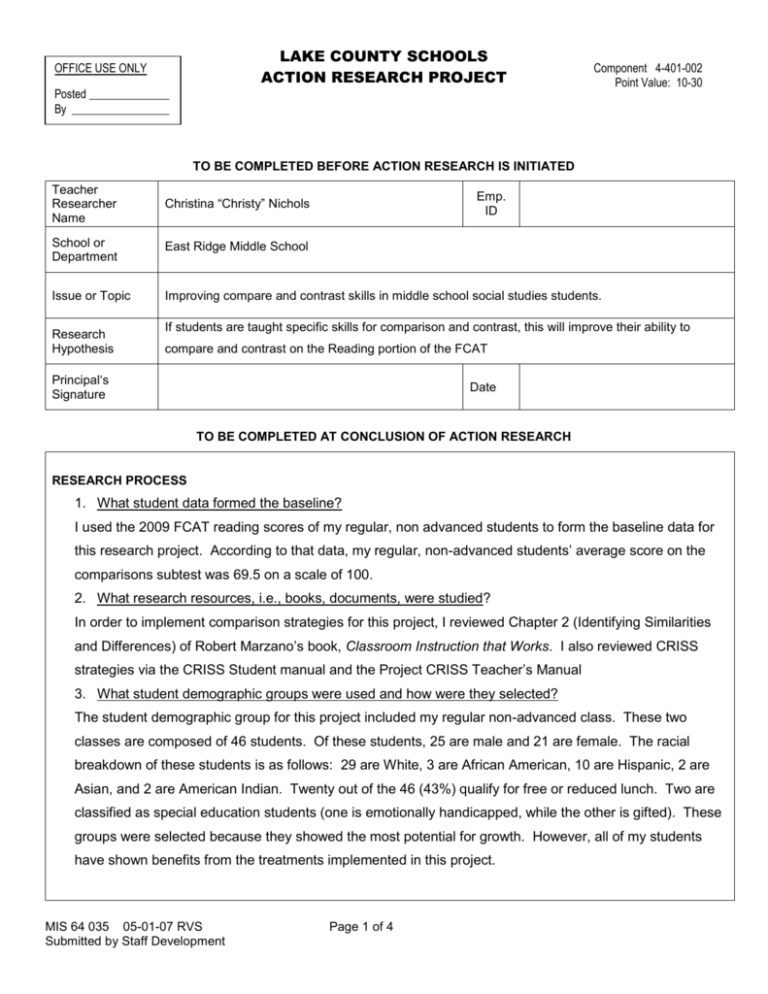
LAKE COUNTY SCHOOLS ACTION RESEARCH PROJECT OFFICE USE ONLY Posted ______________ By _________________ Component 4-401-002 Point Value: 10-30 TO BE COMPLETED BEFORE ACTION RESEARCH IS INITIATED Teacher Researcher Name Christina “Christy” Nichols School or Department East Ridge Middle School Issue or Topic Improving compare and contrast skills in middle school social studies students. Research Hypothesis Emp. ID If students are taught specific skills for comparison and contrast, this will improve their ability to compare and contrast on the Reading portion of the FCAT Principal‘s Signature Date TO BE COMPLETED AT CONCLUSION OF ACTION RESEARCH RESEARCH PROCESS 1. What student data formed the baseline? I used the 2009 FCAT reading scores of my regular, non advanced students to form the baseline data for this research project. According to that data, my regular, non-advanced students’ average score on the comparisons subtest was 69.5 on a scale of 100. 2. What research resources, i.e., books, documents, were studied? In order to implement comparison strategies for this project, I reviewed Chapter 2 (Identifying Similarities and Differences) of Robert Marzano’s book, Classroom Instruction that Works. I also reviewed CRISS strategies via the CRISS Student manual and the Project CRISS Teacher’s Manual 3. What student demographic groups were used and how were they selected? The student demographic group for this project included my regular non-advanced class. These two classes are composed of 46 students. Of these students, 25 are male and 21 are female. The racial breakdown of these students is as follows: 29 are White, 3 are African American, 10 are Hispanic, 2 are Asian, and 2 are American Indian. Twenty out of the 46 (43%) qualify for free or reduced lunch. Two are classified as special education students (one is emotionally handicapped, while the other is gifted). These groups were selected because they showed the most potential for growth. However, all of my students have shown benefits from the treatments implemented in this project. MIS 64 035 05-01-07 RVS Submitted by Staff Development Page 1 of 4 4. What strategies were implemented during the study? During the study, I implemented a Venn diagram strategy. Students are familiar with Venn diagrams, but struggle with creating “quality” comparisons and contrasts. I implemented the following strategy stages: a. First, I worked with students to create Venn diagrams comparing and contrasting objects with which they were familiar (in this case, chocolate chip cookies and oatmeal raisin cookies). As students volunteered similarities and differences to fill in the Venn diagram, I explained to them what “quality” similarities and differences look like and how to create them. b. Next, students had to create several Venn diagrams of their own comparing and contrasting many different things as our studies progressed throughout the year. Students compared and contrasted Hinduism and Buddhism, Indian leaders Asoka and Chandragupta, Mayan and Incan civilization and other things. Each child shared his/her Venn diagram with me and I gave them suggestions to make them better. Eventually, students became quite capable of creating their own quality Venn diagrams. c. Because the eighth grade reading test in the past has included short answer questions that require students to compare and contrast, my next step was to require the students to use their Venn diagrams to write about their comparisons. We began to work on using transition words and organizing their thoughts in a logical way. We are still working on this portion of the strategy 5. What was the timeline for the study? We began work on these strategies in October, 2009. When the new semester began in January of 2010, we began working on the writing portion of the study. We are still working on the writing portion. Approved Disapproved Comments Principal assigns 10-30 points Principal’s Signature Director of Staff Development Signature MIS 64 035 05-01-07 RVS Submitted by Staff Development Date Date Acknowledged Page 2 of 4 LAKE COUNTY SCHOOLS ACTION RESEARCH PROJECT - SHARING THE RESULTS [Complete online and email to Haskinsbj@lake.k12.fl.us] Title of Action Research Project Improving Compare and Contrast skills in Middle School Social Studies Name of Teacher Researcher Christina “Christy” Nichols Name of School East Ridge Middle School Grade Level 7 Answer the following questions in your abstract. DO NOT USE teacher or student names. 1. Classroom Problem: Provide a description of your identified classroom problem. The problem I identified in my class room was comparisons and contrasts. Based on my own observations and experience, I know that middle school students struggle with creating effective comparisons and contrasts. They often focus on the vague and simple. I wanted to teach them to create clear, precise contrasts that focus on a single, specific characteristic. I also wanted them to create comparisons that are specific and evidence higher-level thinking. 2. Research Process: Provide a detailed description of your research process. My research process involved reviewing literature on strategies that help to improve students’ abilities to compare and contrast. I reviewed the CRISS manual, focusing on Venn diagrams. I also reviewed Chapter Two of Robert Marzano’s book, Classroom Instruction that Works. This particular chapter focuses on strategies for students to identify similarities and differences. 3. Collection and Analysis: Provide a narrative summary of your collected and analyzed data. As FCAT reading scores for the 2009-2010 school year have not yet been returned, much of my data is based on completed student work and observations in the classroom setting. Based on this, my students’ ability to create clear contrasts based on a single characteristic has increased dramatically. Before intervention, I might have noted the following “difference” from student work: “Hinduism has many gods while Buddhism was founded by Siddhartha Gautama.” Now, students recognize that they must focus on a single characteristic: “Hinduism has many gods while Buddhism has no major gods.” Further, their identification of quality similarities has increased. They identify similarities that go beyond the vague and obvious. For example, students noted that that Inca and Maya were both “powerful tribes that conquered others, both worshipped sun and moon gods, and both built amazing structures” that are still around today. 4. Action: Provide a summary of your decisions based on your analyzed data. Based on my data, I will continue to implement Venn diagrams as a regular strategy in my classroom. I will continue to make sure that I begin instruction on comparisons and contrasts with objects that students are familiar with and can work with easily. Given that short answer questions MIS 64 035 05-01-07 RVS Submitted by Staff Development Page 3 of 4 will no longer be a part of the FCAT, I am not sure if I will continue the writing piece. I feel however, that writing in the social studies is valuable and has its own merit beyond improving FCAT scores. 5. Professional Reflection: What did you learn through this process? How did conducting action research impact your teaching? Most importantly, I learned that students need to be explicitly taught exactly what quality looks like. Students need to know what target they are trying to hit. Otherwise, they are just shooting blindly. The products you get as a result of this blind shooting might be good or awful. If students are clearly aware of what they need to do to show evidence of understanding, teachers are much more likely to get the products that they can find quality in. ABSTRACT: Based on FCAT scores for the 2008-2009 school year, I realized that my regular, non-advanced students needed to make improvements in their ability to make comparisons and contrasts. After reviewing appropriate literature and implementing new strategies into my regular classes, I was able to see improvements in both their ability to recognize differences and similarities as well as their ability to dig deeper into the items being compared to create quality, higher-level comparisons and contrasts. Source: A Guide to Becoming an Action Research – Department of Education MIS 64 035 05-01-07 RVS Submitted by Staff Development Page 4 of 4
